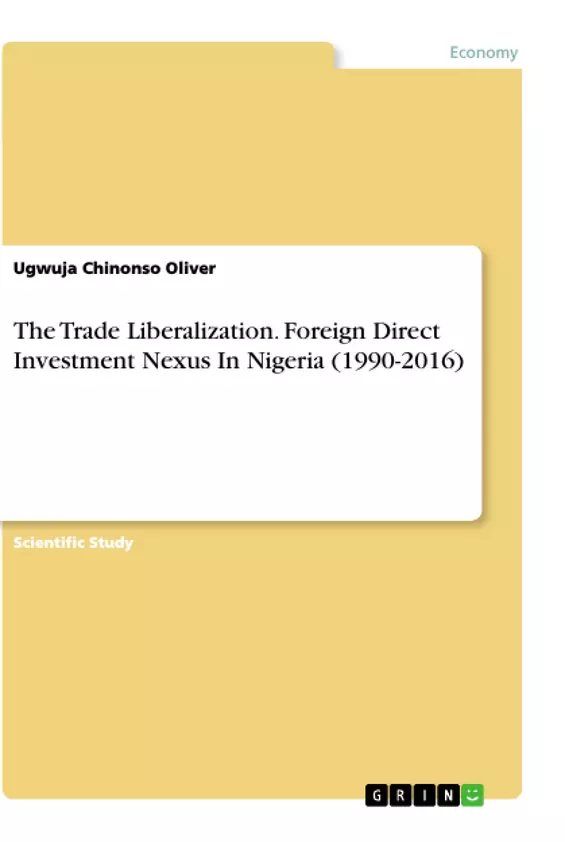The primary objective of this work is to investigate the nature of the relationship between foreign direct investment (FDI) and trade liberalization in Nigeria and to ascertain the direction of causation between FDI and trade Liberalization.
The work seeks to empirically examine the interlinkages between trade openness and foreign direct investment in Nigeria by relying on annual time series data spanning the period 1990-2018 and using the Engle-Granger two-step co-integration test to establish the existence of a stable long run equilibrium relationship among the variables at 5 percent level of significance.
The study employed the Ordinary Least Square (OLS) regression technique and the pairwise granger causality test to validate the nature of the relationship existing between trade openness and foreign investment in Nigeria. Sequel to the regression result, the author found that although openness is statistically insignificant, foreign direct investment responds positively to changes in trade liberalization. Similarly, the granger causality reveals a zero causality between TOPEN and FDI.
Inhaltsverzeichnis (Table of Contents)
- CHAPTER ONE
- BACKGROUND TO THE STUDY
- STATEMENT OF THE RESEARCH
- RESARCH QUESTIONS
- RESEARCH OBJECTIVES
- RESEARCH HYPOTHESIS
- SIGNIFICANCE OF THE STUDY
- DELIMITATION OF THE STUDY
- CHAPTER TWO. SURVEY OF RELEVANT LITERATURES
- CONCEPTVAL FRAMEWORK
- THEORETICAL LITERATURE
- TRADE THEORIES
- THE MERCANTILIST TRADE THEORIES (1500-1600).
- THE ABSOLUTE ADVANTAGE TRADE THEORY (1776)
- THE COMPARATIVE COST ADVANTAGE THEORY (1817).
- THE HECKSHER-OHLIN MODEL
- THE NEW GROWTH MODEL
- EMPIRICAL LITERATURE
- FOREIGN STUDIES
- DOMESTIC STUDIES
- SUMMARY, LIMITATIONS OF PREVIOUS LITERATURE AND VALUE ADDITION
- CHAPTER THREE. RESEARCH METHODOLOGY
- THEORETICAL FRAMEWORK
- MODEL SPECIFICATION
- MODEL ONE FOR OUR PRIMARY OBJECTIVE
- MODEL TWO FOR OBJECTIVE TWO
- ESTIMATION TECHNIQUE
- METHOD OF EVALUATION
- ECONOMIC CRITERIA: A PRIORI EXPECTATIONS
- STATISTICAL CRITERIA: FIRST ORDER TEST
Zielsetzung und Themenschwerpunkte (Objectives and Key Themes)
This study examines the relationship between trade openness and foreign direct investment in Nigeria from 1990 to 2018. Its primary objective is to investigate the existence of a long-run equilibrium relationship between these variables. It utilizes annual time series data and the Engel-Granger two-step co-integration test to establish this relationship. The study also aims to determine the direction of causality between trade openness and foreign direct investment, employing the Ordinary Least Square (OLS) regression technique and the pairwise Granger causality test.
- Trade liberalization and its impact on foreign direct investment in Nigeria
- The role of foreign direct investment in economic growth and development
- The impact of trade openness on the Nigerian economy
- The relationship between trade openness and foreign direct investment
- Policy recommendations for promoting foreign investment in Nigeria
Zusammenfassung der Kapitel (Chapter Summaries)
Chapter One provides background information on the study, including the statement of the research problem, research questions, objectives, hypotheses, significance, and delimitation of the study. Chapter Two explores relevant theoretical and empirical literature on the subject, including trade theories, the relationship between trade liberalization and foreign direct investment, and relevant studies conducted both within and outside Nigeria. Chapter Three outlines the research methodology, including the theoretical framework, model specification, estimation technique, and method of evaluation. It also includes a priori expectations and statistical criteria for evaluating the study's findings.
Schlüsselwörter (Keywords)
The main keywords and focus topics of this study are: trade liberalization, foreign direct investment, economic growth, trade openness, Nigerian economy, Engel-Granger co-integration test, Granger causality, Ordinary Least Square (OLS) regression, policy recommendations.
- Quote paper
- Ugwuja Chinonso Oliver (Author), 2020, The Trade Liberalization. Foreign Direct Investment Nexus In Nigeria (1990-2016), Munich, GRIN Verlag, https://www.grin.com/document/512976



